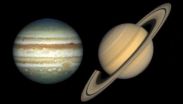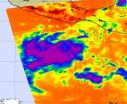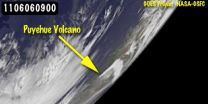(Press-News.org) Jupiter, long settled in its position as the fifth planet from our sun, was a rolling stone in its youth. Over the eons, the giant planet roamed toward the center of the solar system and back out again, at one point moving in about as close as Mars is now. The planet's travels profoundly influenced the solar system, changing the nature of the asteroid belt and making Mars smaller than it should have been. These details are based on a new model of the early solar system developed by an international team that includes NASA's Goddard Space Flight Center in Greenbelt, Md. The work is being reported in a Nature paper posted on June 5, 2011.
"We refer to Jupiter's path as the Grand Tack, because the big theme in this work is Jupiter migrating toward the sun and then stopping, turning around, and migrating back outward," says the paper's first author, Kevin Walsh of the Southwest Research Institute in Boulder, Colo. "This change in direction is like the course that a sailboat takes when it tacks around a buoy."
According to the new model, Jupiter formed in a region of space about three-and-a-half times as far from the sun as Earth is (3.5 astronomical units). Because a huge amount of gas still swirled around the sun back then, the giant planet got caught in the currents of flowing gas and started to get pulled toward the sun. Jupiter spiraled slowly inward until it settled at a distance of about 1.5 astronomical units—about where Mars is now. (Mars was not there yet.)
"We theorize that Jupiter stopped migrating toward the sun because of Saturn," says Avi Mandell, a planetary scientist at NASA Goddard and a co-author on the paper. The other co-authors are Alessandro Morbidelli at the Observatoire de la Cote d'Azur in Nice, France; Sean Raymond at the Observatoire de Bordeaux in France; and David O'Brien at the Planetary Science Institute in Tucson, Ariz.
Like Jupiter, Saturn got drawn toward the sun shortly after it formed, and the model holds that once the two massive planets came close enough to each other, their fates became permanently linked. Gradually, all the gas in between the two planets got expelled, bringing their sun-bound death spiral to a halt and eventually reversing the direction of their motion. The two planets journeyed outward together until Jupiter reached its current position at 5.2 astronomical units and Saturn came to rest at about 7 astronomical units. (Later, other forces pushed Saturn out to 9.5 astronomical units, where it is today.)
The effects of these movements, which took hundreds of thousands to millions of years, were extraordinary.
Jupiter's Do-Si-Do
"Jupiter migrating in and then all the way back out again can solve the long-standing mystery of why the asteroid belt is made up of both dry, rocky objects and icy objects," Mandell says.
Astronomers think that the asteroid belt exists because Jupiter's gravity prevented the rocky material there from coming together to form a planet; instead, the zone remained a loose collection of objects. Some scientists previously considered the possibility that Jupiter could have moved close to the sun at some point, but this presented a major problem: Jupiter was expected to scatter the material in the asteroid belt so much that the belt would no longer exist.
"For a long time, that idea limited what we imagined Jupiter could have done," Walsh notes.
Rather than having Jupiter destroy the asteroid belt as it moved toward the sun, the Grand Tack model has Jupiter perturbing the objects and pushing the whole zone farther out. "Jupiter's migration process was slow," explains Mandell, "so when it neared the asteroid belt, it was not a violent collision but more of a do-si-do, with Jupiter deflecting the objects and essentially switching places with the asteroid belt."
In the same way, as Jupiter moved away from the sun, the planet nudged the asteroid belt back inward and into its familiar location between the modern orbits of Mars and Jupiter. And because Jupiter traveled much farther out than it had been before, it reached the region of space where icy objects are found. The massive planet deflected some of these icy objects toward the sun and into the asteroid belt.
"The end result is that the asteroid belt has rocky objects from the inner solar system and icy objects from the outer solar system," says Walsh. "Our model puts the right material in the right places, for what we see in the asteroid belt today."
Poor Little Mars
The time that Jupiter spent in the inner solar system had another major effect: its presence made Mars smaller than it otherwise would have been. "Why Mars is so small has been the unsolvable problem in the formation of our solar system," says Mandell. "It was the team's initial motivation for developing a new model of the formation of the solar system."
Because Mars formed farther out than Venus and Earth, it had more raw materials to draw on and should be larger than Venus and Earth. Instead, it's smaller. "For planetary scientists, this never made sense," Mandell adds.
But if, as the Grand Tack model suggests, Jupiter spent some time parked in the inner solar system, it would have scattered some material available for making planets. Much of the material past about 1 astronomical unit would have been dispersed, leaving poor Mars out at 1.5 astronomical units with slim pickings. Earth and Venus, however, would have formed in the region richest in planet-making material.
"With the Grand Tack model, we actually set out to explain the formation of a small Mars, and in doing so, we had to account for the asteroid belt," says Walsh. "To our surprise, the model's explanation of the asteroid belt became one of the nicest results and helps us understand that region better than we did before."
Another bonus is that the new model puts Jupiter, Saturn, and the other giant planets in positions that fit very well with the "Nice model," a relatively new theory that explains the movements of these large planets later in the solar system's history.
The Grand Tack also makes our solar system very much like the other planetary systems that have been found so far. In many of those cases, enormous gas-giant planets called "hot Jupiters" sit extremely close to their host stars, much closer than Mercury is to the sun. For planetary scientists, this newfound likeness is comforting.
"Knowing that our own planets moved around a lot in the past makes our solar system much more like our neighbors than we previously thought," says Walsh. "We're not an outlier anymore."
INFORMATION:
Jupiter's youthful travels redefined solar system
2011-06-07
ELSE PRESS RELEASES FROM THIS DATE:
GO Campaign, Lemelson-MIT, and P90X Creator Tony Horton Launch Global Search for Innovators, Granting $50,000 in GO Innovation Awards to Inspire Youth to Solve Real World Problems
2011-06-07
GO Campaign, a non-profit organization supporting orphans and vulnerable children throughout the developing world, Lemelson-MIT, and P90X Creator Tony Horton are announcing the launch of GO's global search for innovators and entrepreneurs who are sharing their innovations with youth and inspiring them to create solutions for the real world community problems they face. Up to $50,000 will be granted annually to GO Innovation Award (GIA) recipients.
In addition to inviting participation in the global search, GO Campaign will call for private sector support by corporations, ...
Archive Systems Unveils OmniRIM Records Center
2011-06-07
Archive Systems, Inc., a leading provider of records and document management services, today announced the release of OmniRIM Records Center, a cloud-based solution that gives organizations the power to access, protect and control their business-critical information. It features Archive Systems' acclaimed physical records management functions, seamlessly integrated with electronic records management capabilities to provide secure lifecycle management of a company's valuable informational assets.
OmniRIM Records Center is the first SaaS-solution to unify electronic and ...
Be it numbers or words -- the structure of our language remains the same
2011-06-07
It is one of the wonders of language: We cannot possibly anticipate or memorize every potential word, phrase, or sentence. Yet we have no trouble constructing and understanding myriads of novel utterances every day. How do we do it? Linguists say we naturally and unconsciously employ abstract rules—syntax.
How abstract is language? What is the nature of these abstract representations? And do the same rules travel among realms of cognition? A new study exploring these questions—by psychologists Christoph Scheepers, Catherine J. Martin, Andriy Myachykov, Kay Teevan, and ...
Good youth programs help teens learn to think not just logically, but strategically
2011-06-07
URBANA – Teens develop strategic thinking skills in youth activities that they rarely learn in the classroom, says a new University of Illinois study of 11 high-quality urban and rural arts and leadership programs.
"In school you learn how government is supposed to work. In youth leadership programs, youth learn how government actually works. They also learn how to influence it," said Reed Larson, a professor in the U of I's Department of Human and Community Development.
Strategic thinking involves more than logic; it involves learning to anticipate the disorderly ways ...
Possible first eastern Pacific tropical depression shaping up on NASA imagery
2011-06-07
NASA's Aqua satellite flew over a low pressure system in the Eastern Pacific and captured infrared imagery that show it to be well-defined and organizing. System 91E is shaping up to likely become the Eastern Pacific's first tropical depression of the season.
Located about 425 miles south of Acapulco, Mexico, System 91E is in a good spot for development: warm sea surface temperatures and low wind shear. Those are two factors needed to help a tropical cyclone develop.
Infrared imagery on June 5 at 19:47 UTC (3:47 p.m. EDT/12:47 PDT) from the AIRS instrument that flies ...
Optimalon Software Released New Excel Add-In 1DCutX for Optimal Linear Material Cutting
2011-06-07
Optimalon Software Ltd. has released 1DCutX, an Excel add-in for design engineers and operations managers that optimizes length-cutting operations for manufacturers that do a lot of linear cutting of construction materials. 1DCutX reads data directly from an open Excel spreadsheet, and instantly generates both the graphical layouts and a detailed cutting report within your Excel workbook. 1DCutX can reduce the usage of linear material by twenty to forty percent, compared to manual cutting.
In addition to minimizing raw material waste, 1DCutX saves time, minimizes production ...
First-of-its-kind fluorescence map offers a new view of the world's land plants
2011-06-07
Scientists from NASA's Goddard Space Flight Center in Greenbelt, Md., have produced groundbreaking global maps of land plant fluorescence, a difficult-to-detect reddish glow that leaves emit as a byproduct of photosynthesis. While researchers have previously mapped how ocean-dwelling phytoplankton fluoresce, the new maps are the first to focus on land vegetation and to cover the entire globe.
To date, most satellite-derived information related to the health of vegetation has come from "greenness" indicators based on reflected rather than fluorescent light. Greenness ...
Mid America Wireless Chooses McCusker and Company for Wireless Phone Extended Warranty Program
2011-06-07
McCusker and Company, a leading nationwide developer of extended warranty protection services for the consumer electronics industry, has been selected by Mid America Wireless to setup its professional extended warranty service to the company's wireless customers.
"Mid America Wireless customers can have the peace of mind that if something goes wrong with their new wireless phone, the strength and experience of McCusker & Company's administrator and underwriting partners are there to take care of all covered claims," said McCusker & Company President ...
3 satellites see eruption of Puyehue-Cordón volcano from space
2011-06-07
NASA's Terra Satellite, the GOES-13 and GOES-11 satellites all captured images of the ash plume from southern Chile's Puyehue-Cordón Volcano this week. The volcano is located in Puyehue National Park in the Andes of Ranco Province of Chile.
The Terra satellite flew over the volcano on June 6 at 14:25 UTC (10:25 a.m. EDT). The Moderate Resolution Imaging Spectroradiometer (MODIS) instrument captured a visible image of the eruption that showed the large ash plume blowing northeast, then to the southeast and over the Atlantic Ocean. The ash plume went at least as high as ...
Joint replacement surgery riskier at hospitals with low surgical volume
2011-06-07
Patients who undergo elective total hip or total knee arthroplasty at hospitals with lower surgical volume had a higher risk of venous thromboembolism and mortality following the procedure. The complications following joint replacement surgery at low-volume sites may be reduced by modifying systems and procedures used before and after surgery according to the findings published today in Arthritis & Rheumatism, a peer-reviewed journal of the American College of Rheumatology (ACR).
The ACR estimates that 27 million Americans over the age of 25 have doctor-diagnosed osteoarthritis ...




